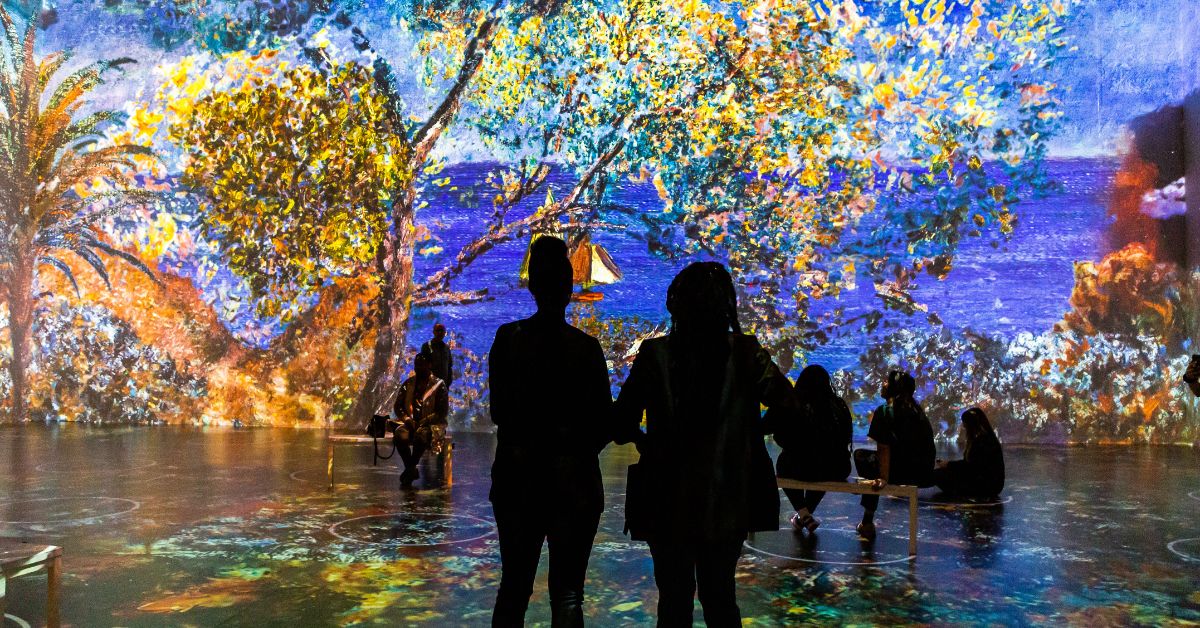How Lighthouse Immersive Captured the Zeitgeist of the 2020s

You have probably spent the past few years trying to forget about the COVID-19 crisis, but maybe you remember the communal isolation. In 2020, when most stores and restaurants in North America remained shuttered, it was unthinkable to consider attending a cultural event. Concert halls lay dark. Movie theaters sat empty. But one company was able to lure people out of their homes and into a new type of immersive experience.
Lighthouse Immersive had just launched in Toronto, and the event company’s first immersive show centered on the post-impressionist artist Vincent Van Gogh. It was part art exhibit, part Instagram pop-up, and wholly unique.
“The province of Ontario had made a special exception to the lockdown rules that immersive art exhibits were allowed to be open because of the fact that we had the air filtration, we had social distancing,” says Wendel Wray, the company’s Global Retail Manager. “Our show used to have projected circles on the ground to be able to have six feet apart from all the groups. We had reduced capacity. We had precautions in place to keep everyone safe.” The effort paid off when Toronto Public Health and the government of Ontario allowed the Immersive Van Gogh Experience to open to the public. “There was actually an exception made specifically for us, which was remarkable.”
For an entertainment-starved populace who had been staring at screens for months, the Immersive Van Gogh Experience was exhilarating. Designed by Massimiliano Siccardi, who had worked on similar experiences in Europe during the early 2000s, the exhibit turned Van Gogh’s paintings into avant garde short films set to music, which looped to pull viewers into paintings and the artist’s life. Most North Americans had never experienced anything like it, and ticket sales took off. More than six million tickets have been sold for the Immersive Van Gogh Experience alone. The company has amassed more than 881 billion media impressions.
As Lighthouse Immersive took their successful exhibits on the road, opening locations in Dallas, San Francisco and other cities across the United States and Canada, the attractions’ gift shops developed a mystique of their own.
“When we opened in Minneapolis—you know, it’s only about a five hour drive from Chicago—our first day we had been open two hours. And this lady came into the gift shop and she’s like, ‘the lanterns, do you have the lanterns?’ I’m like, ‘yes,’” says Wray. “And she’s like, ‘my sister went in Chicago and she got them for her backyard and they look so good. I couldn’t wait for you guys to come here, I wanted them for my backyard.’ And that was the moment that I was like, oh, wow.”
Lighthouse Immersive had gone viral, a must-see attraction as the world opened up again after the COVID-19 crisis. Their offerings expanded beyond Van Gogh, to immersive shows about Frida Kahlo, Oscar-Claude Monet and more. They opened artspaces and launched a monthly magazine. Selfies of people attending their immersive experiences splashed across social media. The fictional Emily in Paris visited a similar show also designed by Siccardi. Madonna wore one of the gift shop’s bucket hats to Coachella. “And we could not keep bucket hats in stock after Madonna was photographed in our bucket hat,” says Wray. “They were selling out in stores. They were sold out online. Everybody wanted a bucket hat. I love that people are finding something that they love so much and really going with it.”
Something else happened around 2021, as well. Immersive art exhibits, specifically exhibits featuring the work of Van Gogh, started popping up everywhere with different, yet confusingly similar, names. Two immersive Van Gogh exhibits opened in New York at the same time. It was so difficult to tell the exhibits apart that now Lighthouse Immersive refers to its show as The Original Immersive Van Gogh Exhibit. The Better Business Bureau issued an alert.
Imitation, they say, is the sincerest form of flattery. In a cutthroat market, the price you pay for having captured the zeitgeist is fending off competitors. It’s hard for even the most successful companies. But Lighthouse Immersive is not done yet. They are going international, with shows opening in Japan, Singapore and Mexico. They recently partnered with Disney to create Immersive Disney Animation.
“It’s so remarkable to see how many people are still engaging with it and still loving it,” says Wray. “It’s exciting. And I’m really excited to see what comes next for us as a company and where we go from here.”
The gift shops at Lighthouse Immersive exhibits are powered by Lightspeed Retail. To see how your business can benefit from Lightspeed’s advanced technology, talk to one of our retail experts.

News you care about. Tips you can use.
Everything your business needs to grow, delivered straight to your inbox.